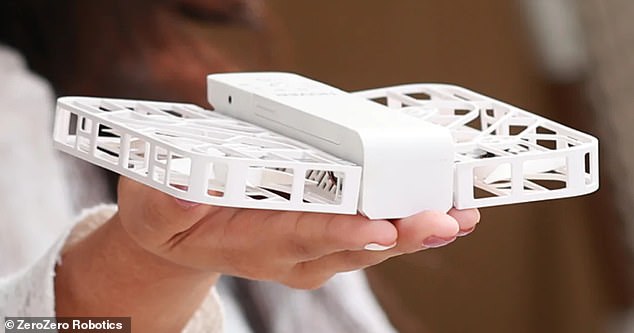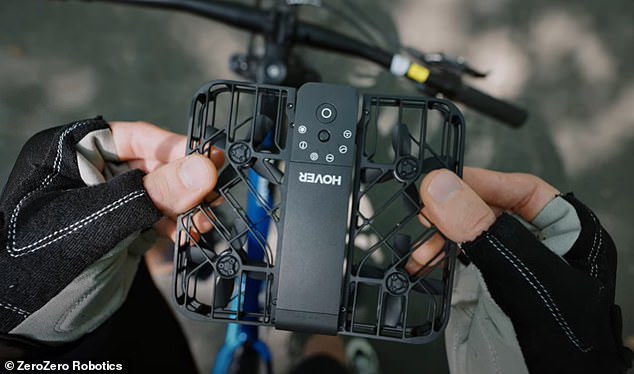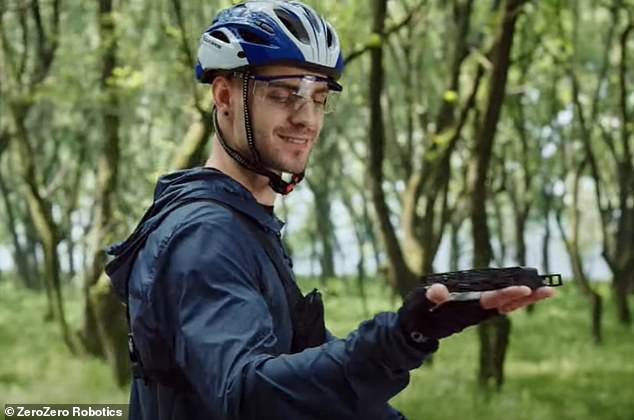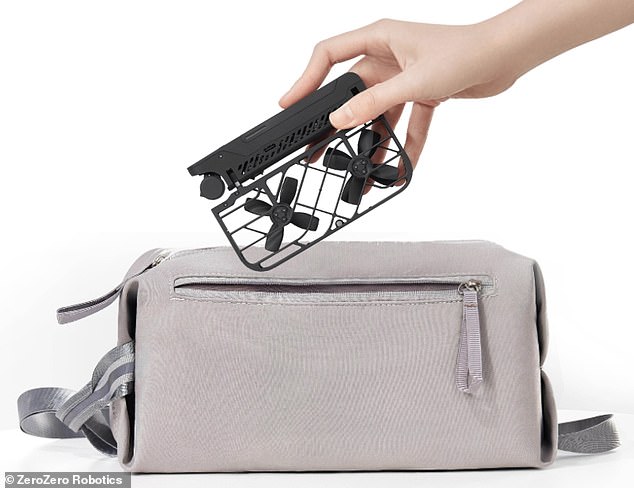Ditch the selfie stick! Tourists can now use an AI drone to follow them around and take pictures
Vacationers can break out the selfie stick – there’s a new gadget in town.
Tourists can now use an AI drone to follow them and take photos.
Launching from the palm of your hand, the HOVERAir
The lightweight device uses AI to stay focused on you and can indicate where to go with simple arm movements.
It may not be for budget travellers, but it costs £419 for the basic package, compared to around £10 for the basic selfie stick.
Vacationers can break out the selfie stick – there’s a new gadget in town. Tourists can now use an AI drone to follow them and take photos

Launching from the palm of your hand, the HOVERAir
The device was shown off at this year’s Consumer Electronics Show in Las Vegas, which is known for revealing the future tech trends that are about to go mainstream.
Selfie sticks have divided the nation in recent years, with sporting events, museums and theme parks – from Wimbledon to the National Gallery – banning people from using them.
Now, instead of a crowd of metal poles blocking their view, tourists will have to deal with the shrill buzz of a swarm of selfie drones.
Unlike the selfie stick, the HoverAir X1 – which weighs 125 grams and can be used both indoors and outdoors – is completely hands-free.
It doesn’t need a controller or app, but instead relies on a ‘Gesture Control’ feature that allows it to follow you by waving your arms.
To operate, users unfold the drone and place it on the palm of their hand with the camera facing them.
After pressing the launch button, the device takes three seconds to register who to focus on and launches into the air.

Most similar to the selfie stick is the basic ‘hover’ option, which tells the drone to stay still in the air at eye level in front of it

It doesn’t need a controller or app, instead relying on a ‘Gesture Control’ feature that allows it to follow you by waving your arms
There are five modes to choose from.
Most similar to the selfie stick is the basic ‘hover’ option, which tells the drone to remain stationary in the air at eye level in front of it.
The camera – which can record high-definition video and audio – always remains pointed at it and can rotate in either direction as the user walks around it.
For a more action-packed shot, users can also opt for ‘tracking’, which allows them to be chased on a bicycle, for example, at speeds of up to 25 km/h in winds of up to 30 km/h.
Or they can opt for ‘bird’s eye’ mode, where the drone shoots up to 4.5 meters in the air and uses the second camera on its underbelly to take an aerial shot.
It can also be used by the more courageous explorers, who operate in temperatures ranging from freezing to 40 degrees Celsius.

For a more action-packed shot, users can also opt for ‘tracking’, which allows them to be chased on a bicycle, for example, at speeds of up to 25 km/h in wind speeds of up to 30 km/h

It can also be used by the more courageous explorers, who operate in temperatures ranging from freezing to 40 degrees Celsius
With an estimated 92 million selfies taken every day, an academic study recently labeled society’s obsession with selfies a “public health problem.”
Since 2008, about 400 injuries or deaths have been reported around the world from people using them.
The victims appeared to most likely be female tourists in their early twenties, with falling and drowning while taking a photo being the two leading causes of death.
Over the past decade, several cultural events and attractions have confiscated selfie sticks
Premier League stadiums have listed them alongside fireworks and knives among their banned items, while several theme parks – such as Alton Towers – have had to ban their use on rides.
The launch of the selfie drone is likely to be welcomed by many influencers, who are now paying hundreds of pounds a day for professional photographers to take their holiday snaps.
Companies like Flytographer and Angel are taking advantage of the boom and connecting travelers with photographers at their holiday destination.
Nicole Smith founded the first ten years ago.
“Since then, tens of thousands of people around the world have used our services to hire a photographer, including solo travelers, couples and more than 20,000 mothers,” she said.
‘It’s so important for mothers to be in the picture, instead of always being the invisible one capturing the moment.’
